Do you need the best overdrive pedal for a solid-state amp? You’ll find all the essential information in this article.
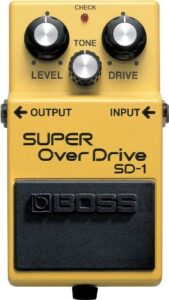
In contrast to most other effects pedals, overdrive pedals help boost your instrument’s tone rather than bring about full-scale change. Unlike distortion pedals, an overdrive pedal delivers gain subtly, loading your tones with some extra sustain, grit, and volume. Nevertheless, the primary function of an overdrive pedal as a guitar effects pedal is to bring about sound ‘coloration,’ i.e., altering your instrument’s output in a specific way.
The type and extent or intensity of coloration is by and large ‘subjective’ as there’s no standardized definition of ‘colors,’ namely differentiation in sound.
However, players of almost all music genres agree that overdrive pedals come in perfectly handy for making a solid-state amp emulate a tube-driven amp’s sound. And if you have a tube-based amp, you’d use this pedal to push the amp further for organic harmonic distortion.
We’ve reviewed six top-notch OD pedals for you, and we hope to choose anyone who will let you achieve what you’re aiming for.
Best Overdrive Pedals for Solid State Amplifiers (Comparison Table)
| Image | Model | Dimensions | Price |
|---|---|---|---|
 | Boss SD-1 Super (Top Pick) | 4 x 6 x 3 | Check Price |
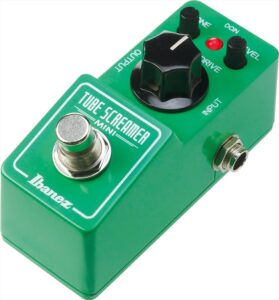 | Ibanez Tube Screamer Mini (Close Runner-Up) | 5.98 x 2.99 x 4.02 | Check Price |
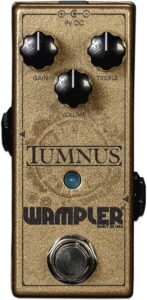 | Wampler Tumnus V2 | 7 x 4 x 7 | Check Price |
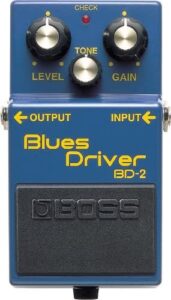 | Boss BD-2 Blues Driver | 3.94 x 3.94 x 1.57 | Check Price |
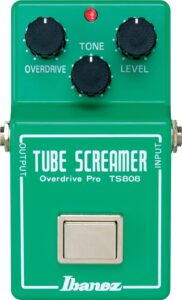 | Ibanez TS808 (Awesome but Pricey) | 6 x 2 x 3 | Check Price |
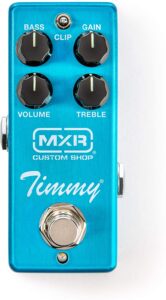 | MXR CSP027 Timmy | 5.5 x 4.5 x 3 | Check Price |
1. Boss SD-1 Super Overdrive Pedal (Editor’s Choice)
In our opinion, it is the best overdrive pedal for a solid-state amplifier available on the market at the moment.
Boss effects pedals set the benchmark for genre-defining sound, and the SD-1 Super Overdrive Pedal embodies that standard. The Boss SD-1 Super Overdrive Pedal introduced in 1981is a veritable powerhouse that has been and continues to be used by guitarists of almost every music genre. The SD-1 modeled on the groundbreaking asymmetrical clipping circuit in OD-1 Overdrive launched in 1977, dials in well-rounded and mellifluous overdrive tones wow players universally.
Going back 43 years, Boss redefined the world of stompboxes by releasing the OD-1, bringing organic overdrive for the first time.
The versatility of the OD-1 pedal lay in that it produced balanced harmonics with its distinctive clipper circuit simulating a tube-driven amp’s sonorous sound, even on a solid-state amplifier. At the same time, the OD-1 overdrive pedal demonstrated its miraculous powers at manageable volume levels.
And within four years, Boss came out with an upgraded version of the OD-1, the SD-1 featuring an intuitive tone control. The tone control knob came in handy for profiling the treble response and making delicate improvements for better low-end clarity. As a result, all players, whether greenhorns or seasoned bassists, can create unique tunes due to their nuanced mid boost and natural character.
Pros
- Incredibly durable
- Singular asymmetrical drive circuit for a unique and genuine overdrive effect
- Warm and soothing distortion
- Gain, tone, and level controls for effortlessly going from gentle to heavy and also for signal boosting
- Reproduces the appropriate tones for playing any musical genre or style
Cons
- The pedal’s tone sounds perfect only when stacked up with other effects pedals.
2. Ibanez Tube Screamer Mini Overdrive Pedal (Close Runner-Up)
Players who’ve once used an Ibanez effects pedal will never switch to other pedal brands, which speak volumes about the unit’s resourcefulness. On the contrary, guitarists who already use various effects pedals will want to go for the Ibanez Tube Screamer Mini Overdrive Pedal for two good reasons. Firstly the TS Mini’s adaptability typified by its articulate sensitivity and iconic midrange snarl is favored by all hues of players.
The second reason why you’d want to pick up the TS Mini is more practical, and realistic-its compactness implies that it takes up minimal space on your pedalboard. Finally, the Tube Screamer will be a prized addition to your guitar rig, thanks to the three plain knobs (that deliver various tones).
Also, the classic green varnish finishing makes the pedal aesthetically appealing and also accentuates your rig’s looks on the whole.
Crafted in Japan, the gorgeous Tube Screamer comes equipped with the Ibanez’s patented JRC4558D IC chip embedded in the TS808 pedal. This overdrive pedal goes a long way in adding meat to your single-coil pickups making the midrange and high-ends stand. In addition, the TS Mini, very much like the vintage TS808 overdrive pedal, is greatly capable of compressing your instrument’s signal for chipping the low-end a bit.
The USP of TS Mini is its capability of ramping up your solid-state amplifier, making your distorted tones more aggressive.
Pros
- A durable and resilient pedal that’ll outlast you (and maybe even your grandchildren)
- Compact design (and hence small footprint) means it occupies minimal space on your pedalboard
- Three intuitive knobs for achieving an assortment of tones
Cons
- Many players have reported that the top-end is excised (and without any dip switch for correcting it)
3. Wampler Tumnus V2 Overdrive Pedal
The Wampler Tumnus V2 Overdrive Pedal, which comes in a neat compact package, effortlessly conjures a gamut of tight tunes. The Tumnus is pricey but offers excellent value for your investment, a highly sought-after overdrive- and guitar effects pedal. Regardless of your playing style and guitar rig, you can take it for granted the Tumnus will invariably be indispensable.
You can use the Tumnus to jack up your solid-state amp’s front end to make it work as a free-standing OD or pair it with another to push up the total gain. And since this pedal is not a true bypass like the introductory OD pedal, it doubles up as a buffer. To put things in perspective, the Tumnus V2 OD pedal comes with a built-in bulwarked bypass that is truly iconic.
Dial in your preferred tones with remarkable ease using the updated and sleek tone, gain, and volume control knobs. Wampler has meticulously researched the different components and ensured that the Tumnus comprises medium and only premium parts. No wonder the tonal range delivered by Tumnus V2 is incredible and cannot be matched by any other OD pedal.
The tone or the treble control allows you to boost the signal quality, which is crucial if you’re using the Tumnus for overdrive. You bet you’ll be pleasantly amazed that this pedal’s volume level is milder than most OD pedals. The gain knob works wonders for you, supplementing the exaggerated signal with grime and grit.
Pros
- As this OD pedal is not an authentic bypass, it can work as a buffer
- Companionable with any playing style or setup
- It comes with a cushioned bypass enabling it to be used as a bumper
- It can be stacked up with other pedals on a pedalboard for shaping total gain
- compact clicking guarantees trouble-free mounting on your pedalboard
Cons
- Boosting the gain could make the sound quite hissy and deafening to be unbearable.
4. Boss BD-2 Blues Driver Overdrive Pedal
The BD-2 Blues Driver Overdrive Pedal from Boss reproduces the vintage bluesy resonance of the overdriven traditional tube amp in a solid pedal. The Boss BD-2 OD pedal can go all the way to offering you a myriad of textures, making you nostalgic. Compared to most distortion stompboxes, the BD-2 furnishes you with a richer distortion characterized by a steeper level of responsiveness.
Players specializing in rock and blues music can make the most of the knobs for tone (treble), gain, and overall level. Stack up the BD-2 Blues Driver Overdrive Pedal with other pedals for rip-roaring amp turn tones the subtlest of overdrive. If you want to dial in that earth-shattering bluesy tenor, you can rely on the BD-2 saturated with temperate overdrive.
You can expect this Boss OD pedal to almost replicate the performance of a vintage tube-driven amp, making it a must-have in your setup. However, if you want to play blues exactly like a seasoned and celebrated player or fine-tune your rock guitar rig, then look no further. Like all other Boss pedals, BD-2 comes encased in a stomp-ready metal box and has a rubberized base and stomp area for stable mounting.
Boss BD-2 is ideally placed to enhance the performance of any tube-driven amp or solid-state amp by adding some sharpness. Stratocaster and Les Paul bassists usually stack up the BD-2 with other pedals on the pedalboard as it fine-tunes the instrument’s high-frequency sound making it more natural. BD-2 integrates the best of SD-1 and OD-1, two extensively popular effects pedals of Boss, and adds gain and edge.
Pros
- Intuitive pedal highly responsive to volume changes and tonal gradation
- Replicates the vintage ‘bluesy’ bass tones of tube-based amps
- Boss five-year limited warranty
Cons
- Sometimes incapable of dealing with higher-gain tones
5. Ibanez TS808 Overdrive Pedal
Featuring overdrive, tone, and volume controls, the Ibanez reissue TS808 Overdrive Pedal carries the identical JRC4558D IC chip as the original. However, the reissue TS808 housed inside a more compact package strives to simulate a tube amp’s compression just like the original. As a matter of fact, for a good number of players out there, the TS808 is their default overdrive pedal.
For blues guitarists, the Tube Screamer 808 is synonymous with a boost pedal, letting them achieve extra gain and midrange smack. The Ibanez TS808 also suits metal players who use this effects pedal typically to roll up the gain for better saturation. Though players never achieve its rated gain of 40dB, the endeavor results in enhanced compression, supplementing the sweetness of the guitar signal.
You plug into chunky, distorted tube-amp style sound when connecting the TS808 OD pedal to an electrical outlet. This brute in green armor has regaled players for decades – Stevie Ray Vaughan created his unique and inimitable tone using the original TS while the contemporary reissue recreates vintage sounds.
Make the most of the reissue TS808 for getting the best out of your solid-state and craft your signature tone.
I also want to note that it shines even brighter on tube amps. However, I could say this almost about any pedal on the list. No surprise – for an authentic tube amp sound, you need a tube amp. Solid-state amps can emulate such sound quality to some, probably relatively high, degree.
Pros
- Classic reissue TS808 that simulates the effects of the original
- Simply plug-in and play: same analog circuit and chip as the introductory Tube Screamer
- LED indicator for displaying battery condition and status of effects
- Pedal housed in zinc die-cast stompbox casing with robust rubber stopper for durability
- Best overdrive pedal for metal on our list
Cons
- Pricey
6. MXR CSP027 Timmy Overdrive Pedal
The CSP027 Timmy Overdrive Pedal by MXR furnishes an intuitive spectrum of textured and granular tones without affecting your instrument’s innate character. Taking inspiration from the iconic Paul Cochrane Timmy overdrive pedal, the MXR CSP027 stands out because it’s ultra-transparent, letting your instrument’s natural tone to the fore. This MXR overdrive pedal is a close reproduction of the original and excels in emulating that classic and engaging low-gain boost.
Also, the compact mini housing implies that you can comfortably mount this pedal with other effects pedals on your pedalboard. The MXR CSP027 Timmy Overdrive Pedal can do an excellent job of pushing up your solid-state amp without coloring the sound. More importantly, the prewired and post-overdrive controls facilitate flattening out the top and sustaining the low-end.
The innovative design of the EQ enables you to maintain the natural character of your tone, while the three-way clip switch offers you numerous headroom settings.
Pros
- It helps maintain the innate character of your instrument’s rig
- Compact housing occupies minimal pedalboard space
- True hardwire bypass
Cons
- Tonal shaping is somewhat restricted owing to band-reject/notch EQ
Do Overdrive Pedals Work Good on Solid State Amps?
Overdrive pedals not only work exceptionally well with tube-driven amps but also perform excellently on solid-state amplifiers. As a result, the ‘overdrive effect,’ one of the various guitar effects before becoming a popular pedal effect, found extensive application as a subordinate or secondary effect. Even before it came to be known as such, the overdrive pedal effect entailed cranking up the volume of a valve tube-based amp.
These were vintage-style amps that came with vacuum tubes under their hood for dealing with amplification. And the tubes had ample headroom for signal handling, thereby enabling players to boost the volume without affecting the guitar’s sound. Then the ‘overdrive effect’ caught on where the tube-driven amps demonstrated clipping effects when they were overfed with power resulting in that legendary ‘overdriven’ tone.
Guitarists can dial in this overdrive with their existing instrument (with a dynamic tube-amp in the rig). However, you can also bring on this natural distortion if you have a standard solid-state amp without turning up the volume to use overdrive pedals to your advantage pair them via your amp’s clean channel. That way, you won’t have to turn up the control knobs or adjust your strumming intensity.
To put it simply, you have ample scope for pairing up overdrive pedals with tube- as well as solid-state amps. Most players think that both SS (solid-state) amps and modeling amps (amps that emulate the sounds of the tube- and even SS amplifiers) work well with OD pedals.
Putting it in perspective, effect pedals (overdrive pedal being one) respond effectively to reverb, delay, and modulation effects such as phaser, tremolo, flanger, and choir. Premium overdrive pedals deliver ‘clean’ overdriven sound without adding gain to the audio chain. Using gain devices is equivalent to carrying out trial-and-error-you miss more often than not, but you do nail it once in a while.
And SS-amps are perfectly placed for boosting or amplifying sound. Often a bespoke interface between your amp and the stompbox does the trick delivering smooth overdrive, fuzz, the coloration of sound. No matter whichever OD pedal you choose, whether you’ll get the desired results (or effects if you like it) or not depends hugely on the type of instrument and amp you use.
Conclusion: The Best Overdrive Pedal for Solid State Amp Is…
Before you can proceed to buy a quality overdrive pedal for a solid-state amp, you should consider certain aspects well in advance. For a start, what exactly are you looking to achieve (from the OD pedal)? Will you use it for thrusting an existing amp or press it into service for making your solos stand out?
The OD pedals reviewed above should enable you to accomplish what you’re looking for, their limitations notwithstanding.
Our winner is the SD-1. It’s the best overdrive pedal for a solid-state amp on our list.